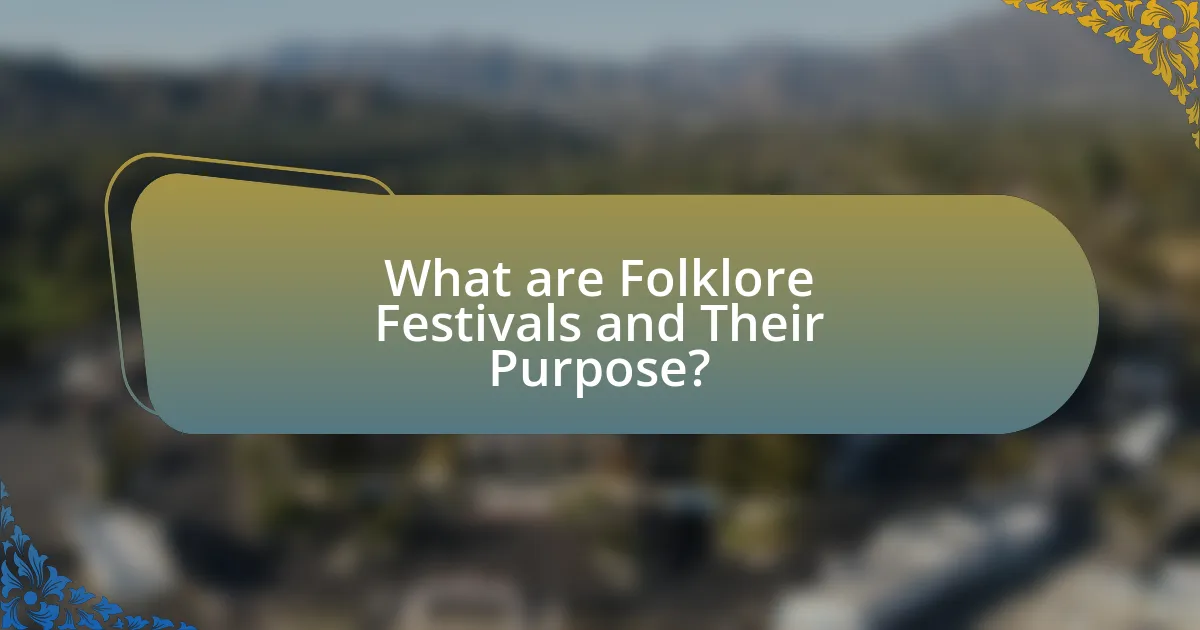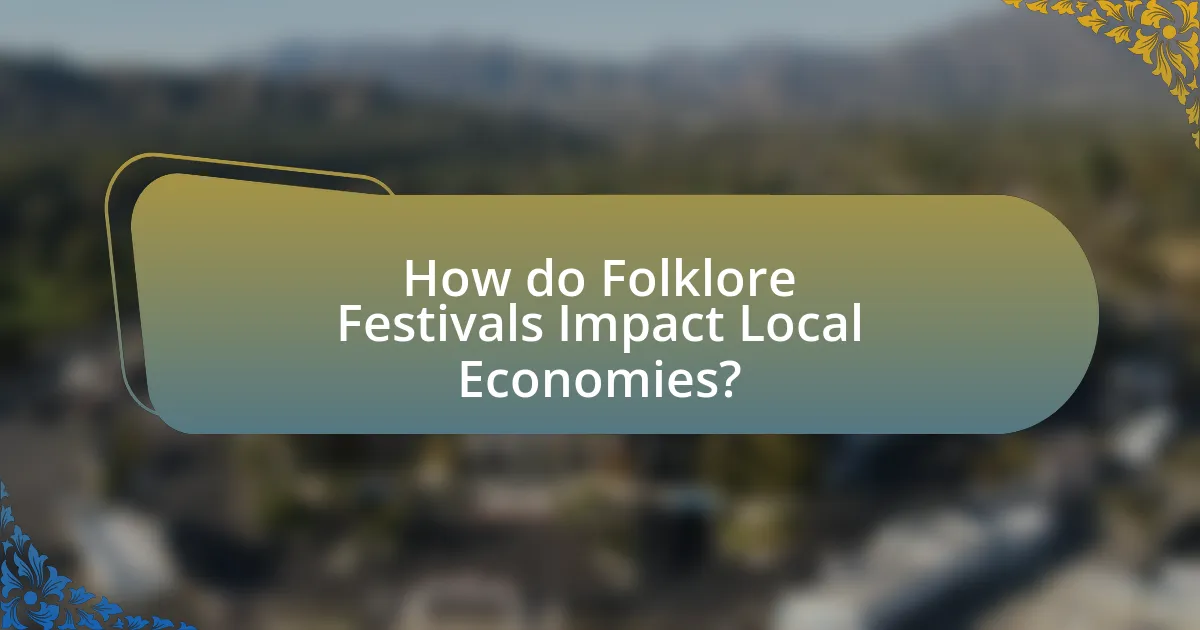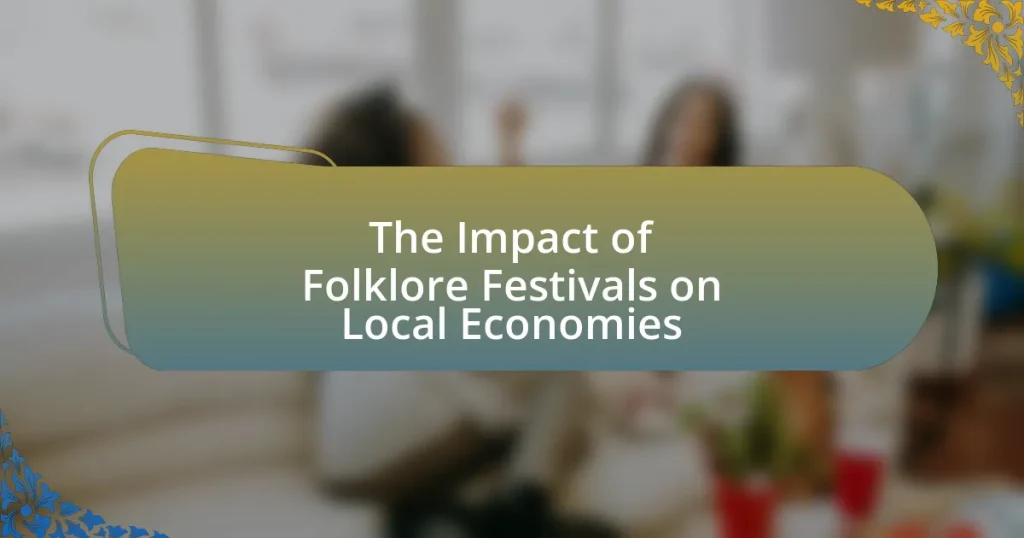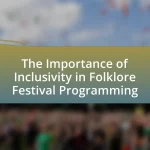Folklore festivals are cultural events that celebrate and preserve the traditions and artistic expressions of communities, playing a vital role in promoting cultural heritage and fostering community identity. These festivals showcase traditional music, dance, crafts, and food, engaging attendees while stimulating local economies through increased tourism and spending. The article explores how folklore festivals contribute to cultural preservation, enhance community engagement, and provide significant economic benefits to local businesses, including job creation and increased sales. Additionally, it addresses the challenges of organizing these events and the strategies that can be employed to ensure their sustainability and long-term impact on local economies.

What are Folklore Festivals and Their Purpose?
Folklore festivals are cultural events that celebrate and preserve the traditions, customs, and artistic expressions of a community or region. Their primary purpose is to promote cultural heritage, foster community identity, and provide a platform for local artists and performers to showcase their work. These festivals often include traditional music, dance, crafts, and food, which not only engage attendees but also stimulate local economies by attracting tourism and generating revenue for local businesses. For instance, a study by the National Endowment for the Arts found that cultural festivals can significantly boost local economies by increasing visitor spending and creating jobs in hospitality and retail sectors.
How do Folklore Festivals contribute to cultural preservation?
Folklore festivals contribute to cultural preservation by actively showcasing and celebrating traditional practices, arts, and narratives that define a community’s identity. These festivals serve as platforms for local artisans, musicians, and storytellers to share their heritage, ensuring that unique cultural expressions are passed down through generations. For instance, the Smithsonian Folklife Festival has highlighted diverse cultural traditions since 1967, emphasizing the importance of preserving intangible cultural heritage. By engaging participants and audiences in these traditions, folklore festivals foster a sense of belonging and continuity, reinforcing community ties and cultural pride.
What traditions and practices are showcased at these festivals?
Folklore festivals showcase a variety of traditions and practices, including traditional music, dance, crafts, and culinary arts. These festivals often feature performances of regional folk music and dance, which reflect the cultural heritage of the community. Additionally, artisans display and sell handmade crafts, such as pottery, textiles, and woodworking, highlighting local craftsmanship. Culinary practices are also prominent, with food stalls offering traditional dishes that represent the area’s culinary history. These elements not only celebrate cultural identity but also attract tourism, contributing to the local economy by increasing visitor spending and supporting local businesses.
Why is cultural heritage important for local communities?
Cultural heritage is important for local communities because it fosters a sense of identity and belonging among residents. This shared heritage enhances social cohesion, as individuals connect through common traditions, languages, and historical narratives. For instance, communities that actively celebrate their cultural heritage, such as through folklore festivals, often experience increased tourism, which can boost local economies. According to a study by the National Endowment for the Arts, cultural events can generate significant economic activity, with festivals attracting visitors who spend money on local businesses, thereby creating jobs and supporting the community’s financial health.
What role do Folklore Festivals play in community engagement?
Folklore festivals play a crucial role in community engagement by fostering social cohesion and cultural identity among residents. These events provide a platform for local artists, musicians, and craftsmen to showcase their talents, thereby enhancing community pride and participation. For instance, a study by the National Endowment for the Arts found that community festivals significantly increase local involvement, with over 70% of attendees reporting a stronger sense of belonging after participating in such events. Additionally, folklore festivals often encourage collaboration among community members, leading to the development of networks that support local initiatives and businesses.
How do these festivals foster community spirit and participation?
Festivals foster community spirit and participation by bringing together diverse groups of people to celebrate shared cultural heritage and traditions. These events create opportunities for social interaction, collaboration, and collective identity, which strengthen community bonds. For example, folklore festivals often feature local artisans, musicians, and performers, allowing residents to engage with and support their neighbors, thereby enhancing local pride and cohesion. Research indicates that participation in community events can lead to increased social capital, as individuals form connections and networks that contribute to a more vibrant community life.
What activities encourage local involvement during festivals?
Activities that encourage local involvement during festivals include community workshops, local vendor markets, and cultural performances. Community workshops allow residents to share traditional crafts and skills, fostering a sense of ownership and pride in local heritage. Local vendor markets provide opportunities for local artisans and food producers to showcase their products, directly benefiting the local economy. Cultural performances, such as dance and music showcases, engage local talent and attract visitors, enhancing community spirit and participation. These activities not only promote local culture but also stimulate economic growth by increasing foot traffic and sales for local businesses during festival events.

How do Folklore Festivals Impact Local Economies?
Folklore festivals significantly boost local economies by attracting tourists, increasing spending in local businesses, and creating job opportunities. These events draw visitors who spend money on accommodations, food, and entertainment, which directly benefits local merchants and service providers. For example, a study by the National Endowment for the Arts found that cultural events, including folklore festivals, can generate millions in revenue for host communities. Additionally, festivals often require local staffing, leading to temporary or permanent job creation in sectors such as hospitality and retail. This economic stimulation can lead to long-term benefits, including increased tax revenues for local governments, which can be reinvested into community services and infrastructure.
What economic benefits do Folklore Festivals provide to local businesses?
Folklore festivals provide significant economic benefits to local businesses by increasing foot traffic and sales during the event. These festivals attract tourists and locals alike, leading to heightened demand for goods and services such as food, accommodations, and crafts. For instance, a study conducted by the National Endowment for the Arts found that festivals can generate millions in revenue for local economies, with some events reporting a 30% increase in sales for nearby restaurants and shops. Additionally, local artisans and vendors often see a boost in sales, as festivals create a marketplace for their products, further stimulating the local economy.
How do festivals increase sales for local vendors and artisans?
Festivals increase sales for local vendors and artisans by attracting large crowds, which creates a high demand for their products. The influx of visitors during festivals leads to increased foot traffic, allowing vendors to showcase their goods directly to potential customers. For instance, a study by the National Endowment for the Arts found that local festivals can boost sales by up to 30% for participating artisans compared to non-festival periods. Additionally, festivals often promote local culture and crafts, enhancing the visibility of vendors and encouraging community support, which further drives sales.
What types of businesses see the most significant impact from these events?
Businesses in the hospitality, food and beverage, and retail sectors see the most significant impact from folklore festivals. These events attract large crowds, leading to increased demand for accommodations, dining options, and local crafts or souvenirs. For instance, a study by the National Endowment for the Arts found that festivals can boost local economies by generating millions in revenue, particularly benefiting hotels and restaurants that experience heightened patronage during such events.
How do Folklore Festivals influence tourism in local areas?
Folklore festivals significantly influence tourism in local areas by attracting visitors who contribute to the local economy. These festivals showcase cultural heritage, traditional arts, and local cuisine, which draw tourists seeking authentic experiences. For instance, the National Folk Festival in the United States attracts over 100,000 attendees annually, generating millions in revenue for host cities through accommodation, dining, and local attractions. Additionally, folklore festivals often promote local artisans and businesses, further enhancing economic benefits. This influx of tourists not only boosts immediate financial gains but also fosters long-term interest in the region, encouraging repeat visits and ongoing tourism growth.
What strategies do festivals use to attract tourists?
Festivals attract tourists through a combination of marketing, unique cultural experiences, and partnerships with local businesses. Effective marketing strategies include targeted advertising campaigns that highlight the festival’s unique features, such as local traditions, music, and food, which appeal to potential visitors. For instance, the Albuquerque International Balloon Fiesta utilizes social media and promotional videos to showcase its vibrant atmosphere, drawing in over 800,000 attendees annually. Additionally, festivals often create immersive experiences that allow tourists to engage with local culture, such as workshops, performances, and traditional crafts, enhancing their overall experience. Collaborations with local hotels, restaurants, and transportation services further incentivize attendance by offering package deals and discounts, thereby boosting local economies. These strategies collectively contribute to increased tourist footfall and economic benefits for the host communities.
How does increased tourism affect local infrastructure and services?
Increased tourism significantly strains local infrastructure and services. As visitor numbers rise, the demand for transportation, accommodation, and public amenities escalates, often outpacing the existing capacity. For instance, a study by the World Travel and Tourism Council indicates that destinations experiencing a 10% increase in tourism can see a corresponding 5% rise in infrastructure stress, leading to congestion and service delays. Additionally, local governments may struggle to maintain public services such as waste management and emergency services, which can become overwhelmed by the influx of tourists. This situation can result in deteriorating service quality and increased operational costs for local authorities, ultimately impacting residents’ quality of life.

What are the Challenges and Considerations for Organizing Folklore Festivals?
Organizing folklore festivals presents several challenges and considerations, including funding, cultural representation, and logistical coordination. Securing adequate funding is crucial, as festivals often rely on sponsorships, grants, and ticket sales to cover costs; for instance, a study by the National Endowment for the Arts highlights that many festivals struggle to meet financial demands, impacting their sustainability. Cultural representation is another significant consideration, as organizers must ensure authentic representation of traditions and avoid cultural appropriation, which can alienate local communities. Logistical coordination involves managing permits, vendor arrangements, and crowd control, which are essential for a successful event; according to the International Festivals and Events Association, effective planning can mitigate risks associated with large gatherings. These challenges require careful planning and community engagement to ensure the festival’s success and positive impact on the local economy.
What logistical challenges do organizers face when planning these events?
Organizers face several logistical challenges when planning folklore festivals, including venue selection, resource allocation, and coordination of vendors. Venue selection is critical as it must accommodate expected attendance while ensuring accessibility and safety; for instance, inadequate space can lead to overcrowding, impacting attendee experience. Resource allocation involves managing budgets effectively to cover costs such as permits, insurance, and staffing, which can strain financial resources if not planned meticulously. Coordination of vendors is essential to ensure a diverse offering of food, crafts, and entertainment, requiring effective communication and contracts to avoid last-minute cancellations or disputes. These challenges can significantly affect the overall success and economic impact of the festival on the local community.
How can organizers effectively manage crowd control and safety?
Organizers can effectively manage crowd control and safety by implementing a comprehensive plan that includes crowd monitoring, clear signage, and trained personnel. Utilizing technology such as surveillance cameras and crowd management software allows for real-time monitoring of crowd density and behavior, which can help in making timely decisions to ensure safety. Additionally, establishing designated entry and exit points, along with barriers to guide movement, minimizes congestion and enhances safety. Historical data from events like the 2017 Manchester Arena attack highlights the importance of preparedness and rapid response protocols, demonstrating that effective crowd management can significantly reduce risks during large gatherings.
What are the financial considerations for hosting a successful festival?
The financial considerations for hosting a successful festival include budgeting for venue costs, permits, staffing, marketing, and entertainment. Accurate budgeting ensures that all necessary expenses are accounted for, which is crucial for financial viability. For instance, a study by the National Endowment for the Arts found that festivals can generate significant local economic impact, with some events bringing in over $1 million in revenue, highlighting the importance of effective financial planning. Additionally, securing sponsorships and partnerships can offset costs and enhance profitability, as evidenced by the success of festivals that leverage local business support.
How can Folklore Festivals be made more sustainable?
Folklore festivals can be made more sustainable by implementing eco-friendly practices such as reducing waste, promoting local artisans, and utilizing renewable energy sources. For instance, festivals can minimize single-use plastics by encouraging vendors to use biodegradable materials and providing recycling stations. Additionally, supporting local artisans not only boosts the local economy but also reduces the carbon footprint associated with transporting goods. A study by the University of California found that events prioritizing local sourcing can significantly decrease environmental impact while enhancing community engagement. Furthermore, integrating renewable energy solutions, such as solar panels, can power festival activities sustainably, aligning with broader environmental goals.
What practices can reduce the environmental impact of festivals?
Implementing waste reduction strategies, promoting sustainable transportation, and utilizing eco-friendly materials can significantly reduce the environmental impact of festivals. Waste reduction strategies, such as providing recycling and composting stations, can decrease landfill contributions; studies show that festivals adopting these practices can divert up to 70% of waste from landfills. Promoting sustainable transportation, like encouraging public transit, carpooling, or biking, can lower carbon emissions associated with festival travel. Additionally, using eco-friendly materials, such as biodegradable utensils and sustainable decorations, minimizes resource depletion and pollution. Research indicates that festivals that prioritize these practices not only lessen their environmental footprint but also enhance community engagement and awareness regarding sustainability.
How can local communities ensure the longevity of their festivals?
Local communities can ensure the longevity of their festivals by actively engaging in sustainable planning and community involvement. Sustainable planning includes creating a budget that allocates funds for future events, ensuring that festivals are financially viable over time. Community involvement fosters a sense of ownership and pride, encouraging local residents to participate in organizing and promoting the festival. For instance, festivals that incorporate local traditions and involve local artisans and businesses not only enhance cultural authenticity but also stimulate the local economy, as seen in the case of the Albuquerque International Balloon Fiesta, which generates millions in economic impact annually. By prioritizing these strategies, communities can create enduring festivals that contribute positively to their local economies.
What best practices can enhance the economic impact of Folklore Festivals?
To enhance the economic impact of Folklore Festivals, implementing strategic marketing and community engagement practices is essential. Effective marketing increases visibility and attracts a larger audience, which can lead to higher ticket sales and increased spending in local businesses. For instance, utilizing social media platforms and local media outlets can significantly boost attendance; a study by the National Endowment for the Arts found that festivals with strong marketing efforts saw attendance increases of up to 30%.
Additionally, fostering partnerships with local businesses can create a mutually beneficial ecosystem. Collaborating with restaurants, hotels, and artisans can enhance the festival experience while driving economic activity. Research from the American Planning Association indicates that festivals that integrate local vendors contribute to a 20% increase in local revenue compared to those that do not.
Moreover, incorporating educational workshops and cultural exchanges can attract diverse audiences and encourage longer stays, further benefiting the local economy. According to the National Association of Counties, festivals that offer interactive experiences can increase visitor spending by an average of 15%.
In summary, effective marketing, community partnerships, and engaging programming are best practices that can significantly enhance the economic impact of Folklore Festivals.
How can collaboration with local businesses improve festival outcomes?
Collaboration with local businesses can significantly enhance festival outcomes by increasing economic support and community engagement. When festivals partner with local businesses, they can leverage resources such as sponsorships, in-kind donations, and promotional efforts, which can lead to higher attendance and increased revenue. For instance, a study by the National Endowment for the Arts found that festivals that engage local businesses see a 20% increase in visitor spending, as local vendors attract attendees and provide unique offerings that enhance the festival experience. Additionally, local businesses benefit from increased foot traffic and visibility, creating a mutually beneficial relationship that strengthens the local economy.
What marketing strategies are most effective for promoting Folklore Festivals?
Effective marketing strategies for promoting Folklore Festivals include leveraging social media campaigns, collaborating with local influencers, and utilizing targeted advertising. Social media platforms like Facebook and Instagram allow for visually engaging content that showcases festival highlights, attracting a wider audience. Collaborating with local influencers can enhance credibility and reach, as they often have established trust within their communities. Targeted advertising, particularly through platforms like Google Ads and Facebook Ads, enables precise audience segmentation, ensuring that promotional efforts reach individuals interested in cultural events. According to a study by the National Endowment for the Arts, festivals that effectively utilize these strategies can see increased attendance and economic benefits for local communities, demonstrating the direct impact of marketing on festival success.















